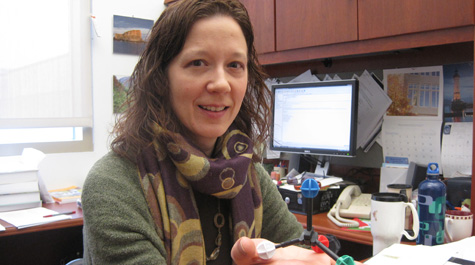Harbron to receive Thomas Jefferson Teaching Award
Elizabeth Harbron, associate professor of chemistry, is the 2011 winner of William & Mary’s Thomas Jefferson Teaching Award, an honor bestowed each Charter Day to a younger faculty member at the College. In early January, she began receiving her nickels—the informal, yet traditional, acknowledgement that members of the College community present to new winners of all Jefferson awards.
Harbron teaches Organic Chemistry I and II, classes that traditionally have enrollments among the highest at any university. At William & Mary, all chemistry majors, neuroscience majors and biology majors have curricular paths that lead through at least one semester of “orgo,” as it’s called. Virtually all health-related pre-professional tracks require two semesters of orgo.
“Anyone who thinks they’re pre-med, pre-pharmacy, pre-dental, pre-vet—all those people have to take a year of organic chemistry,” Harbron said. “We have enormous demand for organic chemistry by that large population.”
That enormous demand is necessarily met through multiple sections of orgo, each having enrollments well over 100—and which can spike, as it did for Harbon in the 2010 spring semester, to 204 students.
Organic chemistry is the study of carbon-based compounds in all their immense variation. Many graduating seniors will agree that the orgo sequence posed their greatest academic challenge throughout college. Harbron says organic chemistry requires not only an immense amount of study, but also developing a grasp of the theme-and-variation nature of molecular structure and reactions.
Furthermore, she says, you need to be able to visualize the molecules.
“It’s a very three-dimensional subject, yet most of our work is done on paper, in two dimensions,” Harbron said. “Orgo students have to learn when it’s appropriate to use this drawing style versus that drawing style and to accurately remember what features each style is meant to convey.”
Harbron says that some students have a harder time than others conceptualizing molecules in three dimensions. She takes particular care with students to inculcate the ability to visualize 3-D structures. Helping a student in her office or describing a molecule’s structure in a small group, Harbron conjures a three-dimensional model out of the air, her right hand cupping and swiveling a benzene group, while her left traces the bond. Then she tilts both hands together and inclines her head to one side to illustrate the 3-D orientation of the molecule.
Those who haven’t quite perfected Harbron’s talent of thin-air molecular visualization can use snap-together molecular model kits that are “as easy to work with as Tinkertoys,” Harbron says. All orgo students have a model kit and use them in class and during tests. An organic chemistry exam is taken to the soundtrack of a liquid pop, pop, popping. It sounds like an shoal of goldfish enjoying a feeding frenzy, but the sounds come from 100 or so orgo students building model molecules, popping colored balls off and on the black stems of their kits.
Organic chemistry classes are taught in the commodious lecture hall officially known as ISC 1127, but almost always called by its old name: Rogers 100. When Harbron takes her place in front of an orgo class, her goal, she says, is to make it feel like a smaller class. To shrink the 180-seat room, the slight, normally soft-spoken chemist scales up her presentation. In her office, she conducts her molecule-conjuring just in front of her face, but in front of a hundred or so William & Mary sophomores Harbron will toss her arms wide and head back to show how a molecule is assembled.
“I have a big, kinda goofy personality in the classroom. Well, goofy probably isn’t the right word,” she said. “I am a little zany. Very energetic. Big gestures—literally and figuratively. I try to use interesting metaphors. When a really dumb joke or pun occurs to me based on the material we’re covering, I say it, because I know that while they’re thinking ‘that’s really dumb,’ my students will remember it.”
In addition to her orgo sections, Harbron also teaches an upper-level elective on organic spectroscopy. She’s an active researcher, as well, working on a number of photochemistry projects with undergraduate research assistants who typically self-recruit from the ranks of her organic chemistry classes. In late 2010, Harbron was named one of six Henry Dreyfus Teacher-Scholars, an honor from the Camille and Henry Dreyfus Foundation recognizes chemists who involve undergraduates in their research.
Chemistry Chair and Professor Christopher Abelt nominated Harbron for the Jefferson award, citing a list of her contributions to teaching and research—and especially her success at combining the two.
“Prof Harbron incorporates many student coworkers into her research projects,” Abelt wrote. “Eleven students have appeared as coauthors on her publications. Of the eleven student coauthors, nine had worked with Prof Harbron since their freshman or sophomore year.”
Harbron’s nomination was supported by colleagues from throughout the world of organic chemistry research. One such letter came from Bruce Armitage, incoming president of the Inter-American Photochemical Society and a professor of chemistry at Carnegie Mellon University.
“Dr. Harbron publishes one paper per year,” Armitage wrote. “The rigor of these papers is excellent and I can only imagine how much depth the students who work on these projects and participate in the writing of the manuscripts acquire. Our conversations invariably turn to mentoring undergraduates and I’ve always been impressed by the absolute commitment and devotion Dr. Harbron expresses for the students she advises and teaches.”















